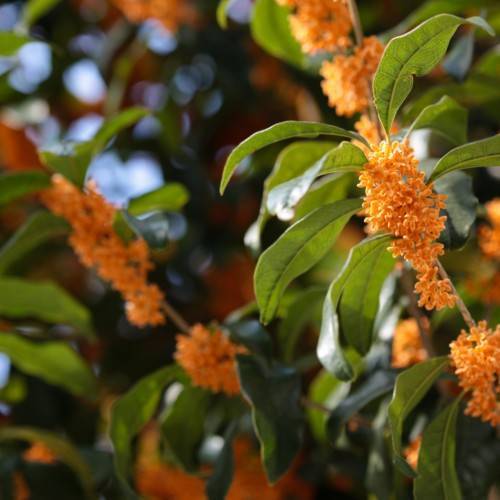
fragrant tea olive
Osmanthus fragrans f. aurantiacus 'Orange Supreme'
Cycle:
Perennial
Watering:
Average
Hardiness Zone:
8 - 11
Flowers:
Flowers In Spring
Sun:
Full sun,part shade
Leaf:
Yes
Growth Rate:
Low
Maintenance:
Moderate
Drought Tolerant:
Yes
Salt Tolerant:
Yes
Care Level:
Medium
watering
The fragrant tea olive (Osmanthus fragrans f. aurantiacus 'Orange Supreme') should be watered when the top layer of soil feels dry to the touch. The amount of water needed will vary based on the soil, humidity, temperature, and pot size. In general, give your tea olive a deep, thorough watering once a week during the growing season. Water thoroughly enough that it reaches the bottom of the pot. Allow the soil to dry out between waterings and never let the soil become mud-like or soggy, as this can cause root rot. During the winter months, water less frequently, only if the soil becomes completely dry.
sunlight
Fragrant tea olives thrive in full to partial sun and require at least 4-6 hours of direct sunlight daily. It’s best to plant them in a spot where they will get at least a few hours of afternoon or early morning sunlight and some shade during the hotter hours of the day. It is important for the tea olives to have some shade especially in the afternoon when the sun is at its peak intensity. Too much sunlight can cause the foliage to turn yellow or brown.
pruning
Fragrant Tea Olives (Osmanthus fragrans f. aurantiacus 'Orange Supreme') are best pruned in late winter. Pruning not only controls the size of the plant, but also encourages flowering. If your Tea olive is planted in a sunny location, it will benefit from a light trimming after flowering. For a mature Fragrant Tea Olive, you should remove up to 1-third of the stem length each year. Start by removing any dead, diseased, or damaged branches back to the trunk. Then, thin out any branches, which are growing too densely or crossing over each other for good airflow. To maintain a rounded shape, prune the shrub into a rounded ‘ball’ slowly and gradually. Be sure to sterilize your tools before and after use to avoid the spread of disease.
